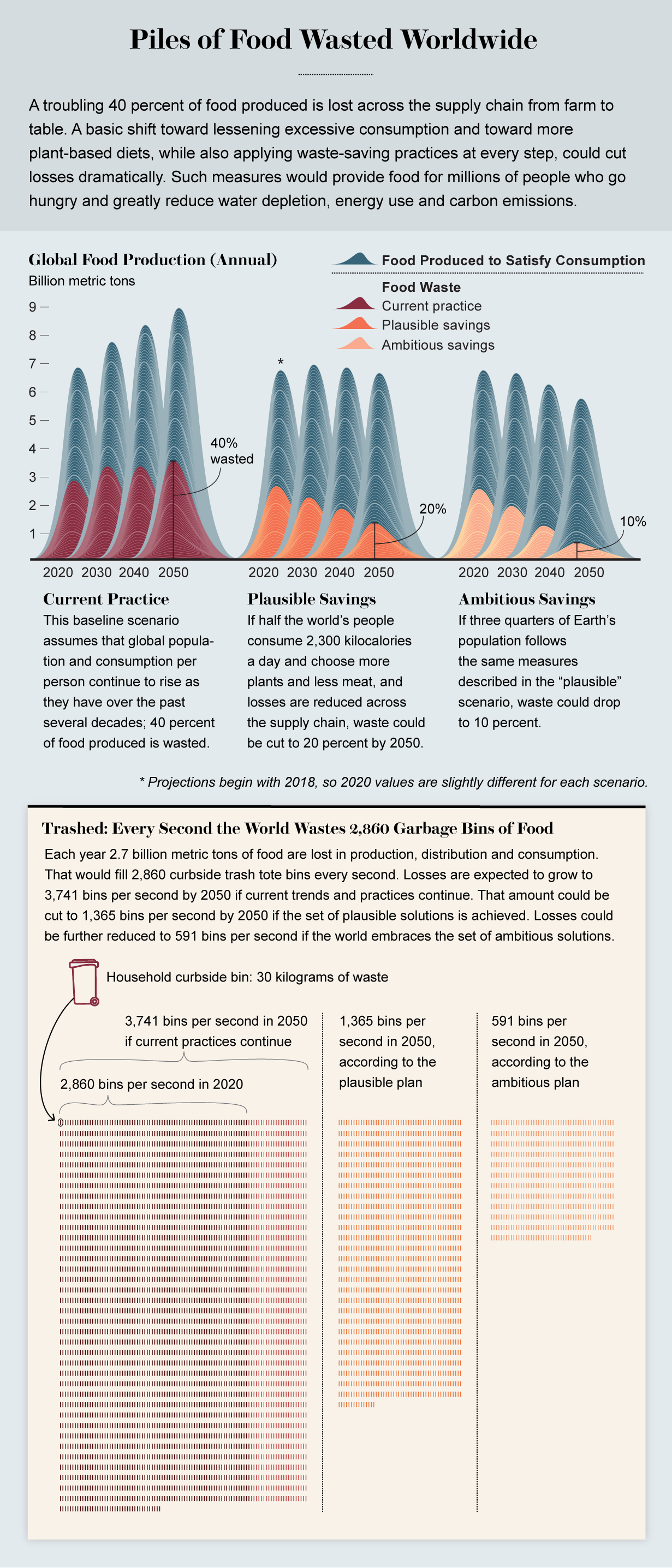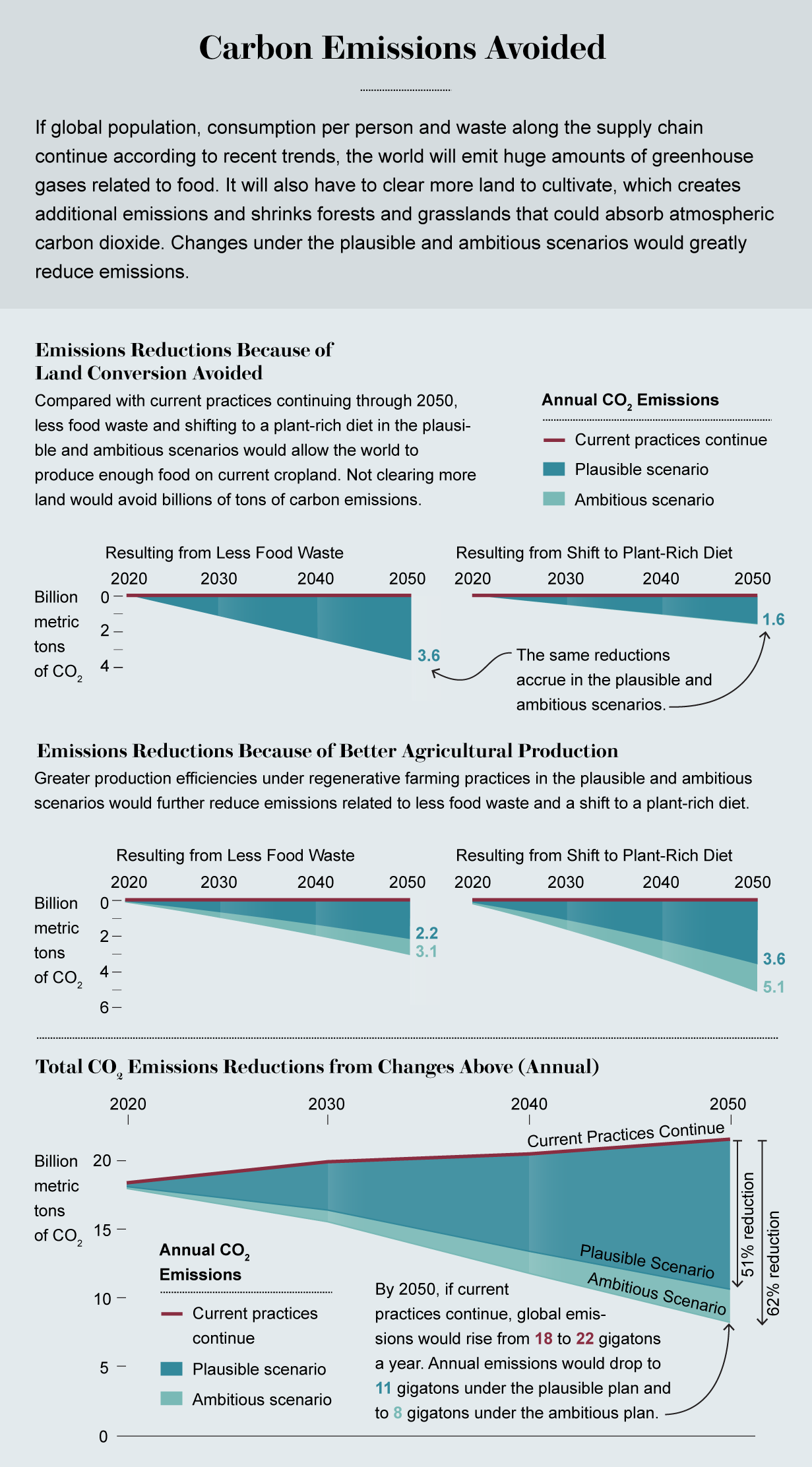Opportunities to reduce waste exist at every step along the supply chain from farm to table. We harvest crops, raise livestock, and process these commodities into products such as rice, vegetable oil, potato chips, perfectly cut carrots, cheese and New York strip steaks. Most of these products are packaged in cardboard boxes, plastic bags and bottles, tin cans and glass jars made from extracted materials in industrial factories, and then they are shipped on gas-guzzling trucks, trains and planes all over the world.
After arriving at stores and restaurants, food is held in energy-hungry refrigerators and freezers that use hydrofluorocarbons—powerful greenhouse gases—until purchased by consumers, whose eyes are often bigger than their appetites, particularly in richer communities. In high-income countries, restaurants and households turn on their energy-consuming stoves and ovens, and in developing nations, billions of people burn biomass in noxious cookstoves that spew polluting, unhealthy smoke and black carbon.
After all these waste-producing activities, too much of the food that makes it to a consumer’s table is thrown in the garbage, which then is typically transported by fossil-fueled trucks to landfills where it decomposes and emits methane, another potent greenhouse gas. Tossing that leftover lasagna accounts for far more emissions than a rotting tomato that never leaves the farm gate. We can do better.
Smaller Foodprint
At Project Drawdown, we poured global data from the Food and Agriculture Organization and many other sources into a detailed model of the entire food production and consumption system. The model took into account rising population projections, as well as greater consumption and more meat eating per person, particularly in developing countries, based on actual trends over the past several decades. According to our calculations, healthier diets and more regenerative agricultural production lead to a lower “foodprint”—less waste, fewer emissions and a cleaner environment.
If half of the world’s population consumes a healthy 2,300 kilocalories a day, built around a plant-rich diet, and puts into practice already proven actions that cut waste across the supply chain, food losses could decline from the current 40 percent to 20 percent, an incredible savings. If we were even more ambitious in following the same practices, food waste could be cut to 10 percent .
These hefty savings would result partly from shifts in basic habits. In the developed world, embracing an average daily 2,300-kilocalorie diet instead of consumption that often reaches more than 3,000 kilocalories lessens food waste in the first place. In the developing world, caloric and protein intake generally need to rise to reach nutritious levels, which may increase some waste across the system. But overall, if everyone on the planet adopted healthy consumption practices and a plant-rich (not necessarily vegetarian) diet, 166 million metric tons of food waste could be avoided over the next 30 years. Feedback would be sent across the supply chain to increase crop production and decrease animal production.
Reducing waste by adjusting how food is produced and consumed can greatly help the environment as well. Different types of foods such as grains, vegetables, fish, meat and dairy have very different environmental footprints. On average, growing and harvesting one kilogram of tomatoes creates about 0.35 kilogram of carbon dioxide emissions. Producing the same amount of beef creates an average of 36 kilograms of emissions. With the entire supply chain taken into account, greenhouse gas emissions from plant-based commodities are 10 to 50 times lower than from most animal-based products.
Additionally, industrial agriculture has spread monocropping, excessive tillage, and widespread use of synthetic fertilizers and pesticides. These practices degrade soil and emit a vast amount of greenhouse gases. Staples are still destroyed in the field by pests and disease and can rot in storage. Livestock consumption of grasses and feed adds further emissions.
Agroecological pest-management practices, such as planting different crops together, and smarter crop rotation can suppress pests and weeds, reducing these losses. Improved livestock-management practices, such as silvopasture, which integrates trees into foraging land, can improve the quality and quantity of animal-based products: more food from fewer hooves in the field and thus fewer resources used and fewer losses. And because regenerative farming practices—which can increase yield from 5 to 35 percent, restore soils and pull more carbon from the air—use compost and manure instead of artificial fertilizers, any food that fails to leave the farm gate can be recycled as natural fertilizer or can be converted by anaerobic digestors into biogas for energy on the farm. More farms need to convert to such practices. Restaurants across the U.S. are helping them through one interesting organization called Zero Foodprint, started by chef Anthony Myint, which takes a few cents added to patrons’ bills to fund regenerative farms in the making.
Saving the Third Bag
In low-income countries, most food is lost before ever getting to market. Improving education and professional training for farmers and producers there, along with innovative technologies, can minimize waste. India’s state of Jharkhand, for example, has installed solar-powered refrigeration units that allow farmers who produce vegetables, fruits and other perishables to store their products without sacrificing quality—a project led by the United Nations Development Program and the Global Environment Facility. In Africa, the Consortium of International Agricultural Research Centers has expanded training that will help local farmers grow more food under conditions being created by climate change, using crops that better tolerate drought and no-till farming to protect withering soil.
In high- and medium-income countries, most waste occurs at the end of the supply chain—markets and households. There consumers have a tremendous amount of power to prevent waste. A good first step is to reflect on what and how much we are buying. This begins with conscious decisions to purchase what we intend to eat and to eat what we purchase. Rather than overstocking on perishables and other products, buying appropriate quantities of food reduces waste. If too much is cooked for the dinner table, properly storing leftovers reduces spoilage, or they can be shared with neighbors, building stronger community ties.
Broader cultural shifts are also required. The “inglorious fruits and vegetables” campaign launched by the French supermarket chain Intermarché in 2014 aimed to avoid waste by changing cultural attitudes toward “imperfect” foods. Markets tend to procure only fruits and vegetables that meet an idealized cultural perception of shape and color. Imperfect produce that does not match these false traits accounts for up to 40 percent of edible fruits and vegetables being discarded before they leave the farm gate. Instead Intermarché sells these fruits and vegetables in special aisles and runs a national marketing campaign glorifying the inglorious. Other retailers are going even further: All the shelves at Danish supermarket WeFood are stocked with products that would have gone to a landfill. Pittsburgh-based 412 Food Rescue distributes nutritious food that was destined for landfills because of imperfections, limited freshness (such as day-old bread) and unclear labeling to communities in need—for free.
Wholesalers, retailers and restaurants can play a significant role in shrinking the waste piles. They can demand that suppliers use more food from local regenerative farms. Ensuring that food items are sold with clear, standardized “sell by/use by” labels helps store managers know when to mark down items, and it helps consumers know when and when not to dispose of food. Restaurant owners can offer different portion sizes and fewer menu items and can encourage patrons to take leftovers home.
Governments and companies that offer food services to employees can jump in, too. U.S. federal government cafeterias serve more than two million people; imagine if the kitchen managers chose to offer plant-rich fare made from perfectly imperfect produce procured from regenerative suppliers. Google is already doing more of that in its cafeterias today.
No matter how conscientious we all are, some food will inevitably be lost across the supply chain. Anaerobic digesters and composting are better ways of disposal than dumping food in landfills because they create soil or generate electricity. Eight states across the U.S. now have laws requiring that organic waste be diverted from landfills to avoid potent methane emissions. The latest Project Drawdown analysis shows that implementing these solutions globally can reduce greenhouse gas emissions by around 14 billion metric tons over the next 30 years.
The real magic happens when a variety of solutions are adopted in parallel and sustained over time. The decisions people make as farmers, executives, grocers, chefs and consumers can prevent enough food loss to feed the world through 2050 without converting any more land. That means together we can eliminate hunger and support a healthier global population. And there would still be enough cropland available to grow plants for organic materials such as bioplastics, insulation and biofuels.
Revamping the food chain and adjusting eating habits will not happen overnight. Nor should we expect to immediately become perfect, regeneratively minded, plant-rich connoisseurs who are fastidious about our purchases and what we waste. Our most fundamental task is to be conscientious about the choices we make—to try to be “solutionists” as much as we can. Toget her we can save that third bag of groceries.















